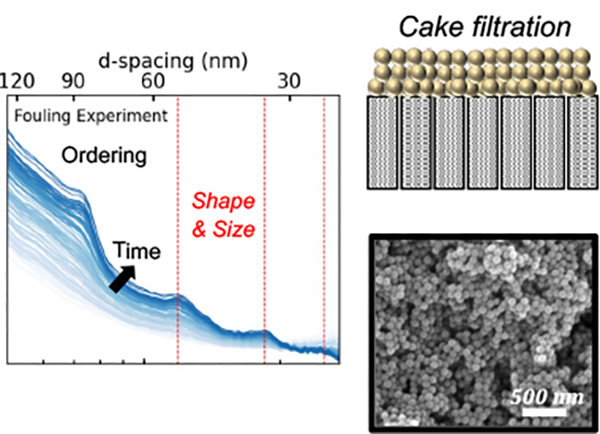SCIENTIFIC ACHIEVEMENT
A new, portable experimental system at the Advanced Light Source (ALS) monitors the accumulation and precipitation of foulants on a filtration membrane under realistic pressurized flow regimes.
SIGNIFICANCE AND IMPACT
This apparatus provides new insight into how fouling occurs in real time and under realistic water treatment conditions, enabling the design of improved, fouling-resistant membranes.

Keeping the membrane clear
Membranes are used for a variety of water treatment applications, from desalination (reverse osmosis, nanofiltration, and electrodialysis) to the removal of bacteria and viruses (ultrafiltration and microfiltration) and potable reuse of municipal wastewater (membrane bioreactors). Compared to conventional treatment technologies (thermal distillation), membranes provide modular, energy-efficient, low-cost alternatives that can be selective for target contaminants.
Despite the benefits, membrane filtration is limited by fouling, where unwanted materials deposit, sorb, or crystallize on the surface of or within the pores of the membrane. As these materials accumulate, it creates resistance on the system, which requires more energy to push water through the membrane and diminishes productivity over time.
To address membrane fouling, researchers traditionally examine the dried material after it collects on the membrane surface to characterize how fouling occurs. This ex situ approach has been beneficial to a point, but the act of fouling is dynamic, and ex situ studies miss the complex, transient fouling behavior that occurs during water treatment.
The physics of fouling
A team of researchers built a portable cart that contains water tanks and remotely-controlled pumps and valves to ensure industrially relevant water flow conditions around the membrane. The cart was wheeled up to Beamline 7.3.3 at the ALS to monitor the in situ fouling process in real time under pressurized conditions.
The high flux of the ALS allowed the team to gather measurements every second to produce timed-resolved data that revealed the transient phenomena that unfolds as fouling occurs. The team analyzed the accumulation of nanoparticles on porous membranes using small-angle x-ray scattering (SAXS). The scattering data provides information on how foulants behave in the membrane environment, particularly particle sizes and their aggregation as a cake on the membrane surface. They also analyzed the crystalline nature of mineral scalants using wide-angle x-ray scattering (WAXS). The diffraction data informs the crystalline phases of inorganic materials precipitating on membranes, such as the transformation of amorphous calcium carbonate to calcite crystals on the membrane surface.
During each experiment, the data was transferred to Berkeley Lab’s National Energy Research Scientific Computing Center (NERSC) where the team could process and evaluate the information quickly, making adjustments to the next experiment to use their beamtime efficiently and gain greater clarity on the fouling process.

The future is clear
This experimental design, which is available for other research groups at the ALS or can be replicated at other facilities, mimics a laboratory-scale, flat sheet membrane testing apparatus. Future research could explore integrating larger, full-scale membrane modules and other membrane types for applications such as electrodialysis into this experimental set up that may be more applicable to industrial water treatment applications.
By tracking membrane fouling in real time under realistic conditions, the team was able to explore the design of a new experimental set-up to understand water chemistry and operating conditions affect the macroscopic membrane performance. This approach offers researchers a way to optimize materials that are already on the market as well as design new filtration technologies that can address more heavily contaminated, non-traditional waters.
Contacts: Matthew R. Landsman and Gregory M. Su
Researchers: M. Nassr, S. Ivandic, N.A. Lynd, K.L. Gleason, B.D. Freeman, and L.E. Katz (University of Texas at Austin), M.R. Landsman (ALS, University of Texas at Austin), E. Schaible, D. McReynolds (ALS), and G.M. Su (ALS, Berkeley Lab)
Funding: Center for Materials for Water and Energy Systems (M-WET), an Energy Frontier Research Center funded by the U.S. Department of Energy (DOE), Office of Science, Basic Energy Sciences (BES) program, DOE Office of Workforce Development for Teachers and Scientists, Office of Science Graduate Student Research (SCGSR) program, and the ALS Collaborative Postdoctoral Fellowship program. Operation of NERSC is supported by the DOE Office of Science Advanced Scientific Computing Research program and operation of the ALS is supported by DOE BES.
Publication: M. Nassr, M.R. Landsman, S. Ivandic, E. Schaible, D. McReynolds, N.A. Lynd, L.E. Katz, B.D. Freeman, G.M. Su, “Crossflow membrane filtration system for operando fouling characterization using transmission x-ray scattering,” Review of Scientific Instruments 96, (2025). doi:10.1063/5.0264117
ALS SCIENCE HIGHLIGHT #529